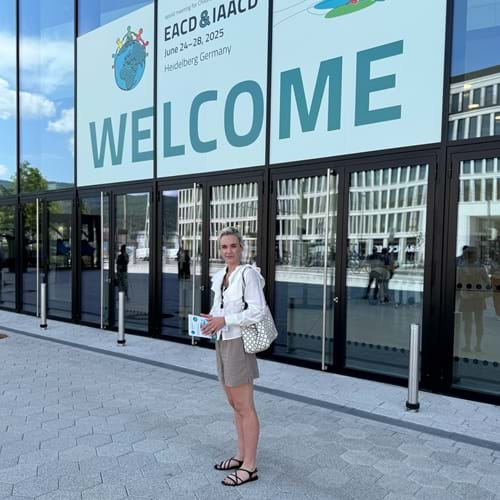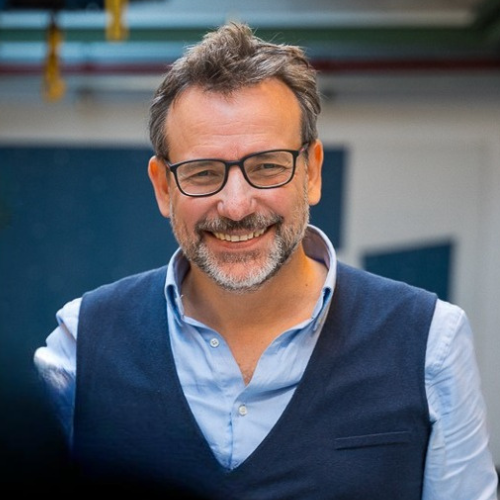Professional conference through a mother’s eyes: “Here, we are all equal”
Every year, the Elsass Foundation offers professionals and parents the opportunity to attend Europe’s largest conference on disabilities. This year, Lisa Emilie Schøler Hartman, mother to a boy with CP, joined for the very first time. Here, she shares what she gained from the experience and brought back to everyday life in Aarhus.
Lively conversations, joyful reunions, and eager glances fill the air. People move in and out among each other in the large conference centre in Heidelberg, Germany. With its visionary architecture and cutting-edge technology, it provides a beautiful setting for EACD, the year’s major professional conference. Among the many participants are several Danes, attending with support from the Elsass Foundation.
The conference is Europe’s largest focusing on children and disabilities. At the end of June, researchers, professionals, parents, and people with CP from around the world gather in the historic German city to share knowledge and concrete experiences at every level. Some participants stand ready with a notebook or their first coffee of the day, while others can hardly wait to get inside and share their research with their international peers.
Networking is in full swing across the room, experiences are exchanged, and glimpses from everyday work are shared. A special energy fills the building - a mix of professional curiosity and shared commitment that only emerges when people with the same passion come together.
Inspiring research
Among those with a notebook in hand and a curious look is Lisa Emilie Schøler Hartman from Hørning near Aarhus. She is mother to 12-year-old Storm, who has CP, and she is one of the parents who received an Elsass Foundation grant to attend the conference.
In her other hand, she holds a program already covered with circles and crosses, marking highlights she doesn’t want to miss over the three-day event.
“I’ve always been fascinated by what’s happening in CP research abroad. I’m very curious about how things are done in other countries and whether we can learn from that in Denmark,” she says, explaining why she applied for the grant.
Alongside several adults with CP, other parents, and professionals, she has the chance to hear about the newest findings on CP and paediatric rehabilitation and to meet both international and Danish experts in the field.

Lisa Emilie Schøler Hartman is one of the parents who received a grant to attend the 2025 EACD Conference. PHOTO: Elsass Foundation
The conference attracts some of the world’s leading researchers and professionals in childhood disability, with the aim of strengthening international collaboration through knowledge-sharing and networking.
An eye-opener
One presentation in particular has already made a strong impression on Lisa: Spanish researcher Roser Pueyo’s talk on the challenges of implementing neuropsychological tests in clinical practice for people with CP.
“It was truly eye-opening to hear her perspective on cognitive testing, which today often assumes that you can speak, write, draw, react quickly, or have good fine motor control - things that can be difficult if you have CP,” says Lisa. She explains that the talk emphasized that the focus should be on tailoring testing conditions to the individual’s needs.
The research team has studied how the brain responds differently in a testing environment, considering factors like who is asking the questions, their length, the surroundings, and the time frame.
“They discussed that maybe the child should stand during the test if they have restlessness, or the room might need to be darkened for sensory reasons. And they looked at how to best test children who use assistive technology to communicate. If a test can’t be completed by the child or adult with CP, it can lead to an underestimation of their cognitive abilities - which can affect education or employment opportunities,” she says.
Lisa explains that it also made her reflect on hospital visits with Storm.
“When Storm needs to be tested or examined, I always tip the doctor off in advance that he likes to talk about football. If they start talking about something he feels confident with, he’s far more likely to open up and describe, for example, his pain,” she says.

Together with other grant recipients, professionals from the Elsass Foundation, and CP Denmark, Lisa attended the annual conference and gained the latest insights into CP research and rehabilitation. PHOTO: Elsass Foundation
Fitting in a box
Lisa has often felt she had to fight for the right treatment and care for Storm, who was diagnosed with CP at age two after a chaotic period of many tests and doctors.
As Storm’s mother, she’s been present for many assessments and often felt that he’s been forced to “fit into a box.”
“That’s why I was so uplifted by this approach to testing. That talk was really the ‘hope of the day’, and it got me thinking: Why don’t we test more holistically? Why do we have to keep fitting people into certain boxes during assessments? And why does it always have to involve a pencil and a timer?” she asks.
A room full of superstars
As a parent to a child with CP, Lisa marked several talks on parental involvement, an issue she cares about a lot.
She was both happy and moved when EACD President Professor Reiner Blank, in his opening speech, spoke about his research into the lack of parental perspective in child assessments.
“Why aren’t parents more involved? When I go into an assessment with Storm, I know I’m entering a room with doctors who are superstars in CP, and I’m not the smartest in the room. But I am the smartest when it comes to my son and his daily life. So how can we work together to make the best plan for him?” she asks.
A global challenge
Another theme she noticed in several of the presentations was how best to support young people and adults with CP.
“It was interesting to hear that every country faces the same question: What happens when a child turns 18? Right now, you’re left to manage on your own. It’s the same in Denmark as in other countries. It’s a global challenge everyone wants to solve, but no one quite knows how,” she says.
She continues: “We were told that this is also the first time the conference has placed such a big emphasis on international networking, so we can learn from one another and break down barriers. I’ve really felt how everyone here is rooting for each other and for the new knowledge being shared.”
Hope and sorrow
It’s Saturday, the final day of the conference. Lisa’s notebook is full of reflections, research to look into, and key takeaways to bring home.
She says the conference has taken her through a wide range of emotions.
“Here, I’ve really felt at home. In Denmark, things can sometimes feel very siloed. But here, we’re all equal. There’s a special atmosphere because everyone shares the same goal: to make a difference for people facing challenges,” she says.
But leaving also brings sadness, knowing that at home, in everyday life, there’s still so much to fight for.

“There’s a special atmosphere here because everyone shares the goal of making a difference for people facing challenges,” says grant recipient Lisa Emilie Schøler Hartman. PHOTO: Elsass Foundation
As chair of the Danish Disability Organisations in Skanderborg, vice-chair of the Disability and Psychiatry Council, board member of CP Denmark East Jutland, and user representative on the national CPOP steering group, Lisa is especially focused on how this new knowledge can make a difference for families with CP in Denmark.
“The new research is so important, but I’m also thinking about how our daily lives at home can improve,” she says, noting that the conference also has a broader purpose.
“It’s about raising awareness and embracing knowledge, rather than just ‘how to do it in daily life.’ And it’s about what we can achieve by helping each other across borders. Can we take what already works well and make it even better? That’s the energy I’m bringing home,” she concludes, before showing a handwritten note she marked as the best message of the day:
“Inclusion is often something people without disabilities try to create for others. But inclusion is something we create together.”

